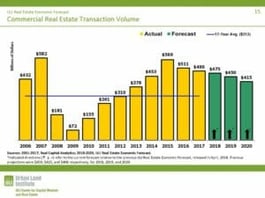
Strong GDP and job growth in 2018 have set the stage for solid real estate demand and absorption, particularly for the rest of 2018 and in 2019. With such data in hand, real estate economists responding to the October 2018 ULI Real Estate Economic Forecast survey waxed optimistic for the real estate market into 2019 and 2020.
The “ULI Real Estate Economic Forecast” is a semiannual survey of economists and analysts at the nation’s leading real estate organizations. Here is a closer look at the numbers.
-
U.S. GDP will grow by three percent in 2018, up from 2.8 percent in the last forecast. Assuming that growth hits this level, this will be the highest calendar-year growth rate of the current expansion. GDP growth is projected to stay strong in 2019 at 2.5 percent, while moderating to 1.7 percent in 2020 (down from 2 percent in the prior forecast).
-
Net job growth should average 1.77 million per year through 2020, compared with a long-term average of 1.15 million. Compared with the last forecast, expected job growth is up in 2018 and 2019 and slower in 2020. Job growth is forecast at 2.4 million in 2018, higher than the past two years and falls to 1 million in 2020, possibly due to concerns about labor availability. The national unemployment rate is forecast to drop to 3.8 percent in 2018 and 2019, the lowest rate since 1969.
-
Commercial real estate prices as measured by the Moody’s/RCA Commercial Property Price Index (CPPI) are projected to rise over the next three years by 6 percent, 5 percent, and 4 percent, respectively), compared with the prior average of 3.4 percent and a long-term increase of 4.4 percent.

Real estate transaction volumes will decline slightly to $475 billion in 2018 (three percent below 2017), the forecast for all three years is up from six months ago, with $450 billion and $415 billion projected for 2019 and 2020, respectively. Despite moderating since the cycle-peak transaction year of $569 billion in 2015, volumes are well ahead of the long-term average of $313 billion and equity and debt capital is readily available for most real estate investments.
-
National vacancy or availability rates are forecast to rise modestly for all property types, over the next three years as solid demand is matched by increased supply. The apartment vacancy rate will increase to 5.2 percent in 2020 from 4.9 percent at YE 2017. Industrial availability will be 7.5 percent in 2020, barely higher than in 2017. The office vacancy rate will increase, ending 2020 at 13.6 percent. Finally, retail availability will reach 9.8 percent vacancy by 2020. The single-family housing construction outlook weakened over the past six months, with starts forecast to rise to 900,000 and 930,000 units in 2018 and 2019, respectively, before slipping to 900,00 units in 2020, all years below the long-term annual average of almost 1 million homes.
-
Rent growth expectations for the next three years rose for hotels (revenue per available room) and apartments, and fell for other property types. Industrial rent growth will lead all property types with 2018–2020 growth averaging 3.2 percent, followed by apartments (2.5 percent), hotels (2.3 percent), office (1.7 percent), and retail (1.3 percent). Except for industrial, rental growth for all property types will be below forecast inflation rates.
Based on this forecast, the U.S. economy will easily surpass the current record for length of expansion (120 months) in mid-2019, according to the report. However, the survey was completed prior to recently announced tariffs by the United States and China that could curtail growth in 2019 and possibly beyond.
Survey respondents also forecast slackening yet positive growth in 2020, attributing this slowdown to a pause in 2017 tax cut–led growth over the next 15 months, if not concerns that the very long current expansion cannot last forever. That said, if growth continues through 2020, the 11-year real estate expansion that started in 2010 will be one of the longest on record.



